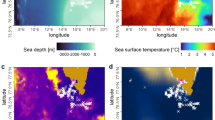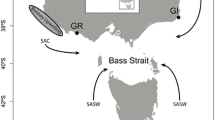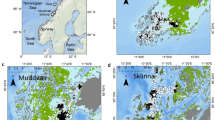Abstract
The pre-laying exodus (PLE) is considered a crucial period in the breeding biology of Procellariiformes as it determines the success of egg production within a season and, therefore, a population’s reproductive output. However, it has scarcely been studied compared to other stages of the annual cycle. Here we present the first pre-laying tracks of the vulnerable Yelkouan Shearwater (Puffinus yelkouan) through the Global Positioning System tracking of birds breeding on the Maltese islands in the Central Mediterranean, and compare PLE core utilisation areas to known areas used during the chick-rearing period. Females spend, on average, 13 days foraging during egg development, reaching an average maximum distance of 325.5 km from their breeding colony to forage at offshore areas mainly south of the Maltese islands; these journeys are of longer duration and cover a greater distance than those undertaken by males, and by females that are not developing an egg, during the same period. There is little to no overlap between the PLE core utilisation areas and those used during chick-rearing by the same populations. This confirms our expectations that the PLE differs from foraging trips undertaken outside of the egg development period. Our results highlight the need for more research into the factors attracting egg-producing females to the PLE foraging areas and the importance of trans-boundary marine protection for the conservation of vulnerable seabirds.
Zusammenfassung
Bewegungen des Mittelmeer-Sturmtauchers (Puffinus yelkouan) im zentralen Mittelmeer vor der Eiablage
Der Pre-laying Exodus (PLE)—das Verlassen der Kolonie vor der Eiablage—wird als ein kritischer Zeitraum in der Brutbiologie procellariiformer Seevögel angesehen, weil er den Erfolg der Eiproduktion und damit die Reproduktionsleistung einer Population maßgeblich mitbestimmt. Allerdings wurde er im Vergleich zu anderen Phasen im Lebenszyklus der Vögel bisher wenig untersucht. Wir stellen hier die ersten GPS-Tracks von PLE-Bewegungen des gefährdeten Mittelmeer-Sturmtauchers (Puffinus yelkouan) von den Maltesischen Inseln im Zentralen Mittelmeer vor und vergleichen die Nutzungs-Kernzonen zwischen den Phasen des PLE und der Jungenaufzucht. Während der Eiproduktion verbrachten die Weibchen im Durchschnitt 13 Tage mit der Nahrungssuche und erreichten eine durchschnittliche Maximalentfernung von ihrer Brutkolonie von 325, 5 km, einen längeren Zeitraum und eine weitere Entfernung als Männchen und als Weibchen die im selben Zeitraum kein Ei produzierten. Innerhalb der Populationen, fanden wir fast keine Überschneidung zwischen den Nutzungs-Kernzonen während des PLE und der Jungenaufzucht. Diese Ergebnisse bestätigen unsere Hypothese, dass PLE und Nahrungsflüge außerhalb der Eiproduktion grundlegend unterschiedlichen Strategien folgen. Unsere Ergebnisse unterstreichen den Untersuchungsbedarf von Faktoren, die die Weibchen während der Eiproduktion zur Nahrungssuche in die PLE–Gebiete bringt und heben die Bedeutung von grenzüberschreitendem Meeresnaturschutz für den Erhalt gefährdeter Seevögel hervor.




Similar content being viewed by others
References
Astheimer LB, Grau CR (1990) A comparison of yolk growth rates in seabird eggs. Ibis 132:380–394
BirdLife International (2018) Puffinus yelkouan. The IUCN red list of threatened species 2016. https://doi.org/10.2305/IUCN.UK.2016-3.RLTS.T22698230A93672084.en
Bivand R, Rundel C (2018) Rgeos: interface to geometry engine—open source (‘GEOS’). R package version 0.4-2. https://CRAN.R-project.org/package=rgeos
Bodey TW, Cleasby IR, Bell F, Parr N, Schultz A, Votier SC, Bearhop S (2017) A phylogenetically controlled meta-analysis of biologging device effects on birds: deleterious effects and a call for more standardized reporting of study data. Methods Ecol Evol 9(4):946–955. https://doi.org/10.1111/ijlh.12426
Bourgeois K, Curé C, Legrand J, Gómez-Díaz E, Vidal E, Aubin T, Mathevon N (2007) Morphological versus acoustic analysis: what is the most efficient method for sexing Yelkouan Shearwaters Puffinus yelkouan? J Ornithol 148(3):261–269. https://doi.org/10.1007/s10336-007-0127-3
Bourgeois K, Vidal E (2008) The endemic Mediterranean Yelkouan Shearwater Puffinus yelkouan: distribution, threats and a plea for more data. Oryx 42(02):187–194. https://doi.org/10.1017/S0030605308006467
Bull LS (2006) Influence of migratory behaviour on the morphology and breeding biology of Puffinus shearwaters. Mar Ornithol 34(1):25–31
Catry T, Ramos JA, Le Corre M, Phillips RA (2009) Movements, at-sea distribution and behaviour of a tropical pelagic seabird: the Wedge-tailed Shearwater in the western Indian Ocean. Mar Ecol Prog Ser 391:231–242. https://doi.org/10.3354/meps07717
Cleeland JB, Lea M, Hindell MA (2014) Use of the southern ocean by breeding Short-tailed Shearwaters (Puffinus tenuirostris). J Exp Mar Bio Ecol 450:109–117. https://doi.org/10.1016/j.jembe.2013.10.012
Development Core Team R (2013) R: a language and environment for statistical computing. R Foundation for Statistical Computing, Vienna
Guilford TC, Meade J, Willis J, Phillips RA, Boyle D, Roberts S, Perrins CM (2009) Migration and stopover in a small pelagic seabird, the Manx Shearwater Puffinus puffinus: insights from machine learning. Proc R Soc B 276:1215–1223. https://doi.org/10.1098/rspb.2008.1577
Guilford TC, Wynn R, McMinn M, Rodríguez A, Fayet A, Maurice L, Meier R (2012) Geolocators reveal migration and pre-breeding behaviour of the critically endangered Balearic Shearwater Puffinus mauretanicus. PLoS ONE 7(3):1–8. https://doi.org/10.1371/journal.pone.0033753
Hedd A, Montevecchi WA, Phillips RA, Fifield DA (2014) Seasonal sexual segregation by monomorphic Sooty Shearwaters Puffinus griseus reflects different reproductive roles during the pre-laying period. PLoS ONE 9(1):e85572. https://doi.org/10.1371/journal.pone.0085572
Jouanin C, Roux F, Mougin JL, Stahl JC (2001) Prelaying exodus of Cory’s Shearwaters (Calonectris diomedes borealis) on Selvagem Grande. J Ornithol 142(2):212–217. https://doi.org/10.1046/j.1439-0361.2001.00073.x
Lascelles BG, Taylor PR, Miller MGR, Dias MP, Oppel S, Torres L, Small C (2016) Applying global criteria to tracking data to define important areas for marine conservation. Divers Distrib 22(4):422–431. https://doi.org/10.1111/ddi.12411
MacDonald MA (1977) The pre-laying exodus of the Fulmar Fulmarus glacialis (L.). Ornis Scand 8(1):33–37
Mackley EK, Phillips RA, Silk JRD, Wakefield ED, Afanasyev V, Furness RW (2010) At-sea activity patterns of breeding and nonbreeding White-chinned Petrels Procellaria aequinoctialis from South Georgia. Mar Biol 158(2):429–438. https://doi.org/10.1007/s00227-010-1570-x
Mallory ML, Forbes MR, Ankney CD, Alisauskas RT (2008) Nutrient dynamics and constraints on the pre-laying exodus of High Arctic Northern Fulmars. Aquat Biol 4:211–223. https://doi.org/10.3354/ab00113
Metzger B, Oppel S, Carroll M, Meirinho A, Dias MP, Barbara N, Lago P (2015) Malta marine IBA inventory report. https://birdlifemalta.org/wp-content/uploads/2018/03/LIFE10NATMT090-MSP-A8_MIBA_Report_final.pdf
Metzger B, Borg JJ, Barbara N, Sultana J (2016) Far beyond the horizon—modern tracking techniques as a tool to identify marine IBAs for Maltese seabirds. In: Yésou P, Sultana J, Walmsley J, Azafzaf H (eds) Conservation of marine and coastal birds in the Mediterranean. Proceedings of the Unep-Map-Rac/Spa symposium, Hammamet, 20–22 February 2015. Tunisia, pp 127–131
Militao T, Bourgeois K, Roscales JL, González-Solís J (2013) Individual migratory patterns of two threatened seabirds revealed using stable isotope and geolocation analyses. Divers Distrib 19:317–329
Nunes M, Vicente L (1998) Breeding cycle and nestling growth of Bulwer’s Petrel on the Desertas Islands, Portugal. Colon Waterbirds 21(2):198–204
Oppel S, Bolton M, Carneiro APB, Dias MP, Green JA, Masello JF, Croxall J (2018) Spatial scales of marine conservation management for breeding seabirds. Mar Policy 98:37–46. https://doi.org/10.1016/j.marpol.2018.08.024
Péron C, Grémillet D, Prudor A, Pettex E, Saraux C, Soriano-Redondo A, Fort J (2013) Importance of coastal marine protected areas for the conservation of pelagic seabirds: the case of vulnerable Yelkouan Shearwaters in the Mediterranean Sea. Biol Conserv 168:210–221. https://doi.org/10.1016/j.biocon.2013.09.006
Perrins CM (1996) Eggs, egg formation and the timing of breeding. Ibis 138(1):2–15. https://doi.org/10.1111/j.1474-919X.1996.tb04308.x
Phillips RA, Silk JRD, Croxall JP, Afanasyev V, Bennett VJ (2005) Summer distribution and migration of nonbreeding albatrosses: individual consistencies and implications for conservation. Ecology 86(9):2386–2396. https://doi.org/10.1890/04-1885
Raine AF, Borg JJ, Raine H, Phillips RA (2013) Migration strategies of the Yelkouan Shearwater Puffinus yelkouan. J Ornithol 154(2):411–422. https://doi.org/10.1007/s10336-012-0905-4
Ricklefs RE (1974) Energetics of reproduction in birds. In: Paynter RA (ed) Avian energetics. Nuttall Ornithological Club, Cambridge, pp 152–292
Spivey RJ, Stansfield S, Bishop CM (2014) Analysing the intermittent flapping flight of a Manx Shearwater, Puffinus puffinus, and its sporadic use of a wave-meandering wing-sailing flight strategy. Prog Oceanogr 125:62–73. https://doi.org/10.1016/j.pocean.2014.04.005
Sultana J, Borg JJ, Gauci C, Falzon V (2011) The breeding birds of Malta. BirdLife Malta, Ta’ Xbiex
Venables WN, Ripley BD (2002) Modern applied statistics with S, 4th edn. Springer, New York
Warham J (1964) Breeding behaviour in Procellariiformes. In: Carrick R, Holgate M, Prevost J (eds) Biologie antarctique. Hermann, Paris, pp 389–394
Wilson RP, Pütz K, Peters G, Culik BM, Scolaro JA, Charrassin J-B, Ropert-Coudert Y (1997) Long-term attachment of transmitting and recording devices to penguins and other seabirds. Wildl Soc Bull 25(1):101–106
Acknowledgements
We thank Edward Jenkins, Juan S. Santiago, Antonio Vilches, Nancy del Carro, John J. Borg, and volunteers for assistance in the field, and Maria P. Dias for assistance with the mIBA protocol. We would also like to acknowledge two anonymous reviewers for their constructive feedback. This study was carried out as part of BirdLife Malta’s EU-LIFE + Malta Seabird Project (LIFE10NAT/MT/090) and EU-LIFE Arċipelagu Garnija (LIFE14NAT/MT/000991), both co-funded by the LIFE programme of the European Commission and the Maltese Ministry for the Environment, Sustainable Development and Climate Change, in partnership with the Royal Society for the Protection of Birds, the Portuguese Society for the Study of Birds and Transport Malta. We dedicate this work to the memory of Joe Sultana. All birds were handled and tagged by trained bird ringers under the licences of the local authorities (Environment and Resources Authority NP 20/16 and NP 0121/16).
Author information
Authors and Affiliations
Contributions
B. J. M. planned the study; P. L., M. A. and B. J. M. carried out the fieldwork; M. C. G. and A. S. B. L. analysed the data; M. C. G. drafted the manuscript; P. L. created the maps; all the authors were involved in writing the manuscript.
Corresponding author
Additional information
Communicated by N. Chernetsov.
Publisher’s Note
Springer Nature remains neutral with regard to jurisdictional claims in published maps and institutional affiliations.
Rights and permissions
About this article
Cite this article
Gatt, M.C., Lago, P., Austad, M. et al. Pre-laying movements of Yelkouan Shearwaters (Puffinus yelkouan) in the Central Mediterranean. J Ornithol 160, 625–632 (2019). https://doi.org/10.1007/s10336-019-01646-x
Received:
Revised:
Accepted:
Published:
Issue Date:
DOI: https://doi.org/10.1007/s10336-019-01646-x




